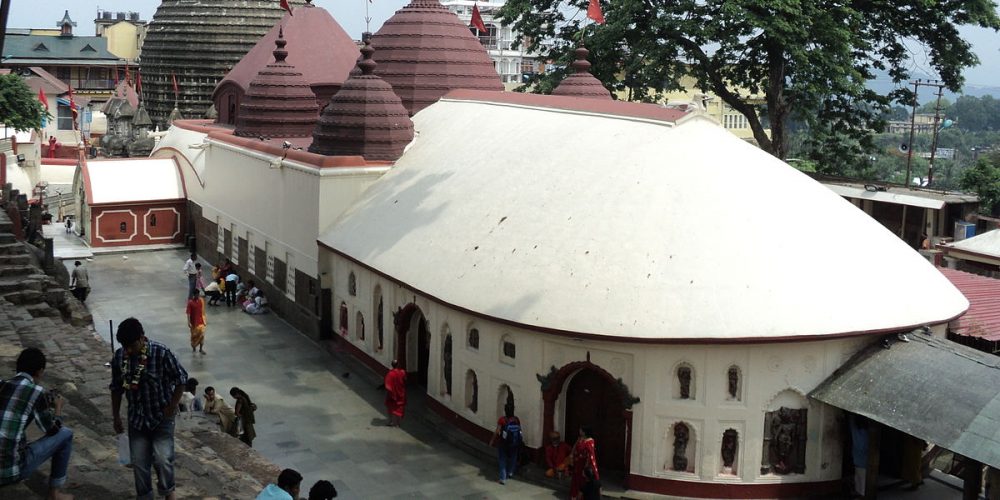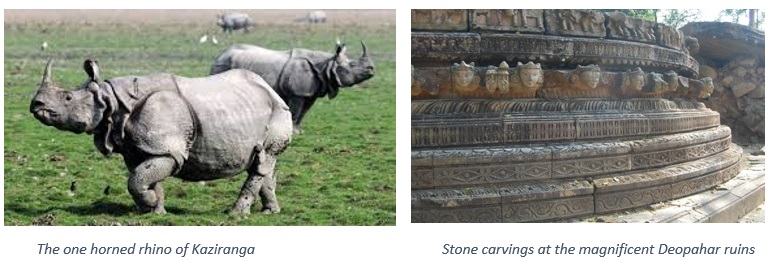We landed at Guwahati in the afternoon, an hour journey from Kolkata by air. The Brahmaputra is a grand river splitting Assam roughly in the middle forming upper and lower Assam. Kamarupa, the ancient Assam kingdom, existed from 350 CE to 1140 CE. At its height, Kamrupa covered the Brahmaputra Valley, North Bengal, Bhutan, and parts of Bangladesh, West Bengal, and Bihar. Though it broke into smaller pieces, the name Kamarupa is now associated with the Guwahati region of Assam. Guwahati was also known as Pragjyotishpur in olden times; Mahabharata and Ramayana have references to this name. In the 16th century the Ahoms came into prominence and became the rulers of the Kamarupa kingdom.
We made a beeline for Kamakhya temple in the afternoon on an Uber taxi. Guwahati literally moves on Uber, and it would be a sensible idea to have this app. Kamakhya is one of the oldest Shaktipeeths of the country, defining the North-East of our country. Temples geographically define India and the Kamakhya temple prominently sits on the Eastern point. Situated on the Nilachal Hill, it is the main temple in a complex of individual temples dedicated to the ten Mahavidyas: Kali, Tara, Sodashi (Tripurasundari), Bhuvaneshwari, Bhairavi, Chinnamasta, Dhumavati, Bagalamukhi, Matangi, and Kamalatmika. It is an important pilgrimage destination for Hindus, especially Tantric worshippers.
Kalika Purana describes Kamakhya Temple as the place where her yoni (organ of procreation) fell after Shiva danced with the corpse of Sati. It mentions Kamakhya as one of four primary shakti peethas: the others being the Vimala Temple within the Jagannath Temple complex in Puri; Tara Tarini, near Brahmapur, Odisha; and Dakhina Kalika in Kalighat, Kolkata.
The current temple built and renovated many times in the period 8th-17th century belongs to a hybrid indigenous style called the Nilachal type: a temple with a hemispherical dome on a cruciform base. The temple consists of four chambers: garbhagriha and three mandapas locally called calanta, pancharatna and natamandira aligned from east to west.
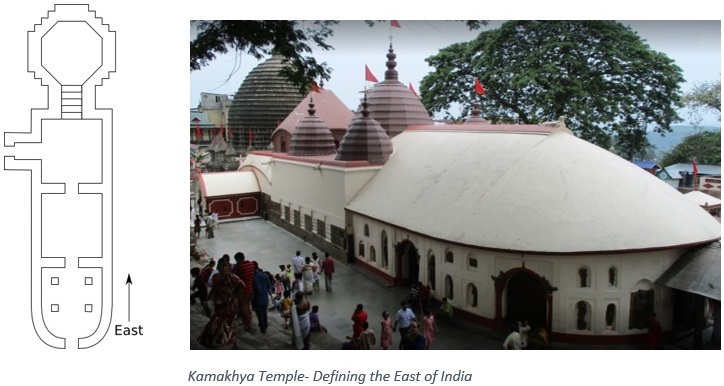
 The garba gruha or the sanctum sanctorum as is true of most temples in Assam is at a lower level; and is unlighted, except by lamps. Consistent with the legend, there are no idols in the main area. The garbhagriha is small and dark; and reached by narrow stone steps. Inside the cave there is a sheet of stone that slopes downwards from both sides meeting in a yoni-like depression. Water fills this hollow constantly from an underground spring. This vulva-shaped depression symbolises the goddess Kamakhya herself and considered as most important pitha (abode) of the Devi. The most famous festival of this temple is the Ambubachi mela, held annually in the monsoon season, and associated with the tantric ritual of the period of menstruation of the goddess. This Shakti temple allows animal sacrifices during specific occasions. The tantric route of salvation is not very popularly known in the Hindu tradition, and unfortunately subjected to plenty of biases due to ignorance. The crowds can be huge; and it is best for the affording and the pressed for time to take a special ticket costing about five hundred Rupees (a bit steep) to cut the line.
The garba gruha or the sanctum sanctorum as is true of most temples in Assam is at a lower level; and is unlighted, except by lamps. Consistent with the legend, there are no idols in the main area. The garbhagriha is small and dark; and reached by narrow stone steps. Inside the cave there is a sheet of stone that slopes downwards from both sides meeting in a yoni-like depression. Water fills this hollow constantly from an underground spring. This vulva-shaped depression symbolises the goddess Kamakhya herself and considered as most important pitha (abode) of the Devi. The most famous festival of this temple is the Ambubachi mela, held annually in the monsoon season, and associated with the tantric ritual of the period of menstruation of the goddess. This Shakti temple allows animal sacrifices during specific occasions. The tantric route of salvation is not very popularly known in the Hindu tradition, and unfortunately subjected to plenty of biases due to ignorance. The crowds can be huge; and it is best for the affording and the pressed for time to take a special ticket costing about five hundred Rupees (a bit steep) to cut the line.
DAY 2
Sualkuchi, one of the largest weaving villages in the world, is about 45 kilometres from Guwahati. We visited this wonderful place the next day. It is the place which is known for the incredibly famous Assam silk. We drove past beautiful deep yellow mustard fields, a sight to soothe any eye. Assam silk’s speciality is that its shine never goes away. In fact, the claim is, the shine increases with time. This needs confirmation, of course. On route, we visited two temples called the Dirgheswari temple dedicated to the Shakti and the Doul Gobinda temple, which is famous for its Holi festival celebrations. We also saw the huge IIT-Guwahati campus from outside, secretly hoping that the sight of the very place might motivate my daughter in her educational endeavours!
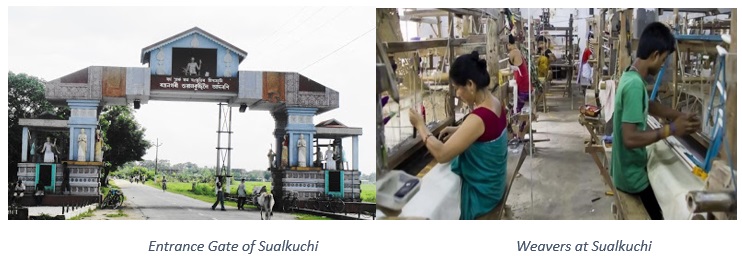 People consider Dirgheswari temple, situated on the northern banks of river Brahmaputra, as the second holiest place after Kamakhya. Access to the main temple needs a small climb. Ahom king Swargadeo Siva Singha (1714 CE-1744 CE) built the present temple under the supervision of Tarun Barphukan, the Ahom viceroy of Lower Assam. Dirgheswari temple is a Shakti Peetha. Many ancient rock images exist in within the temple premises, the date of which is unknown. The main attraction of Dirgheswari temple is the annual Durga Puja celebrations. This temple too is known animal sacrifices. The garbha griha or the sanctum sanctorum housing the idol of Goddess Durga is sited underground, in a small cave.
People consider Dirgheswari temple, situated on the northern banks of river Brahmaputra, as the second holiest place after Kamakhya. Access to the main temple needs a small climb. Ahom king Swargadeo Siva Singha (1714 CE-1744 CE) built the present temple under the supervision of Tarun Barphukan, the Ahom viceroy of Lower Assam. Dirgheswari temple is a Shakti Peetha. Many ancient rock images exist in within the temple premises, the date of which is unknown. The main attraction of Dirgheswari temple is the annual Durga Puja celebrations. This temple too is known animal sacrifices. The garbha griha or the sanctum sanctorum housing the idol of Goddess Durga is sited underground, in a small cave.
Doul Gobinda Temple is another important visit in Guwahati. It is situated on the on the foot hills of Chandra Bharati hill at Rajaduar, North Guwahati. Lord Krishna is the main deity here. The first construction of temple was more than one hundred and fifty years ago. A major renovation happened in 1966. The temple is known for its Holi celebrations for five days, when various programmes attract thousands of pilgrims from far-off places. One can approach this temple by a ferry too from Guwahati.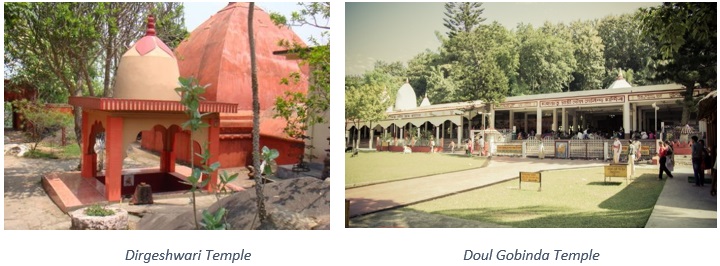
DAY 3
Next day, we visited the Umananda temple, an important Shiva temple, situated on the Peacock Island in the middle of the Brahmaputra river. The island is known to be the smallest inhabited riverine island in the world. We had to reach there by a ferry. The temple stands on a hill called Bhasmacala or Bhasmakuta. King Gadadhar Singha (1681–1696), one of the ablest and strongest rulers of the Ahom dynasty, built the original temple in the 16th century. An earthquake destroyed the temple in 1897, and a rich local merchant rebuilt the temple. Being a Vaishnavite, he interestingly chose to inscribe the interior of the temple with Vaishnavite slogans. The main sanctum sanctorum is again set in a depth. The ferry ride was great; and it was some hard bargaining with the boat guy. They have this habit of random quoting (a common hazard at most tourist places), and finally we settled for Rs. 500 for the to-and-fro transport of three passengers. The government run ferry service is only Rs 20, but there are some fixed timings, and it would do well if the timings are known beforehand.
Outside the ferry point, there was this park dedicated to a great man called Lachit Borphukan. His story was certainly awe inspiring. My eyes suddenly opened to the fact that there were some great warriors in the North East too, something missed completely by our Delhi based writers of school textbooks. Lachit Borphukan was a legendary general, who defeated the Mughals decisively on the famous Battle of Saraighat which took place in 1671. The Ahoms were great ship builders and they could defeat the larger and the more powerful Mughal fleets on the Brahmaputra using smaller and more manoeuvrable boats. The story of his life is the stuff of legends. It came as a surprise to me that the best outgoing cadet of NDA gets the Lachit Borphukan medal. The Ahom kings and generals should hold a greater interest to historians. But of course, a breed of political historians and writers see the importance to Lachit Borphukan as a Hindu right-wing promotion. It is sad that Indian history writers and journalists rarely try to instil any pride amongst Indians about our past heroes. The tag of greats stays rigidly fixed on Akbar and Ashoka only. Any other story fixes into an agenda or a controversy unfortunately.
In the afternoon, we visited the famous Assam handicrafts museum situated near the ferry point. The place is worth spending a healthy number of hours and for sorting out all the purchases and the gift articles. There is also the North-East handicrafts emporium just opposite. These two places are brilliant and can take care of all your shopping needs concerning the local curios and local expertise. It is a necessary visit place in Guwahati. Unfortunately, they do not do transport service; and hence many of the items, especially the furniture not suitable for planes or trains, are difficult to purchase. 
DAY 4
We visited the Navagraha temple the next morning, which is atop a hill. The temple is very ancient and has huge Shivalingas placed as the Navagrahas. The arrangement of Shivalingas as the Navagrahas is indeed unique. Again, the sanctum sanctorum is at a depth and it is very dark inside as there are no lights. The Navagraha Temple is situated on Chitrachal hill in the south eastern part of Guwahati. Inside the temple are Shiva lingams clad in a different coloured cloth representing Surya, Chandra, Mangala, Budha, Brihaspati, Shukra, Shani, Rahu, and Ketu. An earthquake destroyed a part of the temple including its tower, but later rebuilt. King Rajesvara Singha in 1752 A.D. built the present temple., We went to the Assam State Museum after that, only to see its gates firmly closed! Unfortunately, we could not come back. It closes on second Saturdays being a governmental institution; and one visiting Guwahati must take care not to plan a second Saturday for a visit the place. It closes on government holidays too and has fixed opening and closing hours. One should check before going. It certainly looked big and impressive, and I do not know what treasures lay inside. Hopefully, we may visit it later.
We went in the afternoon to a vegetarian joint called Chennai Kitchen and we were happy to be at an exclusive vegetarian restaurant. The staff of the hotel were all in lungis to create an authentic South Indian feel, and it was heartening for a soft-core South Indian to see that! The food was great, indeed a delight. Any vegetarian tourist in Guwahati can visit the place at least once. Non-vegetarian food is quite prominent and famous in the North-East, but delicious vegetarian food is available freely too. I think Chennai Kitchen should offer me a commission for the advertisement I am giving them. It is on the happening Dispur-Shillong road, a road where most of the malls are situated.
In the evening, we had the most fantastic river cruise on Brahmaputra. The cruise includes an entertainment programme, and a lovely dinner in the end. It was worth the money. There was this wonderful short film on the legendary Lachit Borphukan which raised goosepimples in everyone. A Bihu dance followed; and the artists were fantastic. In the end came a singer who managed to get everybody on the dance floor grooving to old Hindi numbers! The two hours on the river flew.
Brahmaputra is a grand river; and it is a great sight to see ships cruise on the river. It starts in China, near to the origins of Ganga, and then takes an eastward run. It curves peculiarly around the Himalayas to enter Assam near Dibrugarh, a place where the opposite bank is difficult to discern from town side bank. The river cuts Assam into two parts; upper Assam and lower Assam. It is indeed no wonder that the Brahmaputra is the crucible of Assam culture, history, music, and literature. If there is a definition of a grand river, then this is it. It then enters Bangladesh and drains off into the Bay of Bengal. No visit of Assam is complete without the river cruise. For those with limited times and other dinner engagements, there is a shorter version too without the dinner and the entertainment stuff. We happened to take both to squeeze maximum happiness!
 DAY 5 AND DAY 6
DAY 5 AND DAY 6
It was off to Kaziranga the next day after a leisurely breakfast and lunch. The beautiful road to Kaziranga from Guwahati gave us a glimpse of the beauty of Assam valley. The villages were quaint, the houses nicely kept, and the general feeling of cleanliness was obvious. We reached Kaziranga in the evening and checked into a hotel. The next day, after breakfast, we proceeded to have a jeep safari of Kaziranga wildlife sanctuary. It was a two-hour safari and great fun. We were naturally excited to see the world famous one-horned rhino, housed only in the North East of India. The animal is impressive, huge, and very calm. Nature never ceases to surprise me. All the powerful animals are vegetarians and are very calm by nature! They are a good advertisement for vegetarianism. We saw a variety of beautiful birds, deer, wild boars, and the rhinos from close quarters. Of course, there were elephants too. It is unfortunate that poaching of the rhinos is going on despite all the laws. Greed defines humans; and there seems to be no hope in the present state of evolution.
In the afternoon, we visited a place called Deopahar, a 45-minute drive from Kaziranga. Well maintained roads and very neat villages along the way made the journey pleasant. We had to climb a mountain to find the ruins of an old temple built perhaps in the 15th century. The temple was huge and without any second thought, impressive. Stunning was the beautiful view from the top of the mountain; and one just wonders how anyone could have built such a super structure at the top of the hill. There is a road; and there are steps now. The forts of Rajasthan, the temples of Tamil Nadu, and temples like these always will make one wonder of the high engineering skills of the Indian past. With all the science and technology at hand, too bad we cannot build a road today which can last a single monsoon. The temple itself dedicates to Vishnu and there were amazing carvings depicting the story of Ramayana. The Eastern boundary of the country is no doubt defined by Kamakhya and perhaps this temple too. I can only imagine people of the olden times making a pilgrimage to these places from remote corners of the country. The unfortunate thing is; the ruins are in a state of neglect. It is a hot tourist spot and I would bet a similar place in a western country making millions. It is such an awe-inspiring place that I would be happy to see it as necessary accompaniment to anyone visiting Kaziranga.
 DAY 7
DAY 7
The next day, we had an elephant safari ride. We had to be up by 4 am and were at the park in the dark by 5 am. The procedure was elaborate. The actual ride was just about an hour, but it was great fun. I am sure it would not have been so for the poor elephant. The domestic elephants are for the safari in the morning; and in chains for the rest of the day. The guides treat them with great fear and respect. Humans have certainly mastered the art and science of safe scares and thrills from the backs of a benign strong animal or in mechanised jeeps with armed protection.
We had a nice leisurely morning walk outside the resort after coming back. The countryside was so beautiful. We wondered why people took off to foreign countries when all the beauties lay not so hidden in our own country. We realized that we had just walked across to the most beautiful Karbi Anglong district bordering the Kaziranga National park. The largest district in Assam, Karbi Anglong (literally meaning ‘Karbi hills’ or ‘the hills of the Karbi tribe’) is sprawled across 10,434 square kilometres, of which about 77 percent is under forest cover. This district has five wildlife sanctuaries, two elephant reserves and 17 District Council Reserve Forests (DCRFs). Karbi Anglong, home to many aboriginal ethnic tribes, is the heart of Assam. The enchanting hill district with its diverse flora and fauna has remained largely untouched and untapped. Dense forests, waterfalls, paddy fields, and hills define this pristine area and we resolved a future visit to this place.
After a very leisurely breakfast, we went to see a luxurious ethnic village established at Kohora, Karbi Anglong near the Kaziranga National Park. Karbi Anglong Autonomous Council (KAAC) along with its tourism department, to highlight ethnic patterns of Karbi region tribes, has built 12 luxury huts here (Rengma, Karbi, Kuki, Dimasa, Adivasi, Mantai, Khasia, Nepali, Tiwa, Bodo, Assamese, and Garo tribes). The park itself was in a state of disarray, and we were sadly one of the few visitors after an exceedingly long time! The concept was unique. The houses were beautiful but suffered from a lack of maintenance. It is a wonderful but neglected park and requires urgent action for revival.
We then went to a theme park which housed all the orchid varieties of Assam. Assamese cuisine is available for the foodies; and there is a central stage where daily performances of Bihu dances and other folk recitals take place. There is a local produce shop too and a small lake to have an old-fashioned boat ride. The whole place was fantastic in its concept and one can spend a few hours here imbibing the best of Assamese flora, fauna, culture, and tradition. It is again a must see for anyone visiting the Kaziranga National Park.
One cannot leave Assam without touching a tea garden or a tea-factory, and we did precisely that. We took some permissions and managed to get inside a tea-factory owned by the Tata group. The manager took us around and showed us the intricacies of making tea. Tea cultivation is for 8 months in a year; and 4 months is hibernation period. December was hibernation period when the machinery gets complete overhauling. There are two types of tea; the CTC (cut, tear, and curl) and the powdered tea. The manager took us on a fascinating journey of making tea. The machines, surprisingly, were rather simple. There was no great or elaborate technology. But tea apparently is like wine. The taste of tea is dependent on a variety of factors. Heat, humidity, soil, the season of plucking, the processing and fermenting comes all into play to decide the taste. There are professional tea-tasters who decide on the quality of the tea. The best quality tea however goes abroad! Most of the Indian tea is the powdered form as we are not very fond of the CTC tea. At least, that is what I gathered. But, most surprisingly, we realized that the tea-bag variety is the poorest quality tea. It is literally the dust which comes out during the tea making process. We sip it in trains and all public places and there are great ads enticing us to dip the bags and make the tea stronger! The fact is, the dust tea packed in tea bags is a classic selling of a poor-quality stuff through slick advertising. That was the TIL moment of the day.
The time to pack off! Some great moments, some wonderful experiences, which made us resolve a repeat visit to the beautiful North-East and perhaps cover all the eight states (‘Seven sisters’ with later addition of Sikkim). We flew back to Hyderabad early next day. It is great to fly with Air India. There is good leg space, and there is always something to eat, depending on the time. The modern low-cost airlines have become very scary. One must just fly and pay for everything else: leg-space, snacks, early check-in, early baggage claim, air, water, looking, reading, lights above your head, conversing with your neighbour- anything wished for! Keep the mouth firmly shut is the golden rule of flying with the low-cost airlines. The modern hospitals and the hotels have become something like this too. I would think that these are all modern business models of printers at a cheap cost and mind-blowingly expensive cartridges.
Anyway, we came back with lasting memories. Assam, along with the other North-Eastern states is a must recommend for every Indian and foreigner. The natural beauty, the religious places, and the history is equally rich, if not more, than the other popular places of India like Rajasthan, Goa, and Kerala. Unfortunately, Assam and other North-East states are rarely on the radar of the regular tourists; and this needs correction. I do hope that celebrity brand ambassadors create more awareness and interest in this sparkling jewel of India.
Featured Image: Wikipedia

